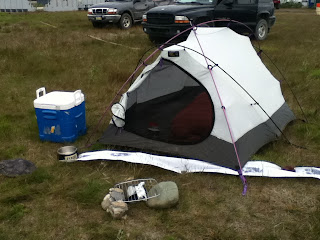Actually, a fair chunk of that silent period was work. I had a very busy fall. I was looking at my numbers the other day, and so far this fiscal year (since Oct. 1), I've already had contact with around 1000 students. In November I gave 44 "programs." So, what is it that this park ranger really does?
A program is what we call a lesson, presentation, talk, etc. During the school year, my programs are usually about an hour long and are in a classroom with one class at a time. The teachers contact me, sign up for a date / time and ask for a certain topic, usually from a list of topics I give them as suggestions. Then, I use a lesson plan we already have prepared for that topic and age group, or I write one if we don't have one made. Of course, since I work for the Park Service, our lessons have to benefit our own mission, so they have something to do with conservation or education about the natural and cultural resources of our parks here. Locations / names of parks, park and park service history, careers in the park service, and parks for personal enjoyment are also themes in our lessons. I tend to get most interest from the elementary teachers here in Kotzebue, so I might return to a given class 3 or 4 times during the school year. Often though, especially if I'm traveling to a village, I only have one opportunity to work with a certain group of children that year, so our lessons are meant to be fun, active and engaging. Since this is my third school year, many of the elementary and middle school kids know me, and they're always really excited when I visit. Sometimes the teachers will have them write thank-you letters, and they can be rewarding and pretty entertaining too. Some kids say some pretty funny things! I'll post some program-related things below...they may not be about the same one.
The little kids here (anywhere really) are just adorable. The tiny ones are "all up in your grill" as they say, and it can be difficult trying to to make them feel bad as you shake them off! Going into this job, I knew I would be contacting kids of all ages from all over the region, throughout the winter in the Arctic. I assumed it was a recipe for illness! To my surprise, my first (just about) two years were without incident. Then this spring I got strep throat in Kobuk, and this fall I got a nasty stomach bug in Kivalina. I'm hoping that will be all for a while.
 |
| Kids as "sled dogs" |
 |
| Actual sled dogs |
Some programs include a little bit of art (not my strength). This is a short, simple art project I sometimes do after learning about the northern lights.
 When I first got here I thought kids probably weren't impressed with natural things: skulls, bones, fur, preserved animals, etc. I imagined they got to see and handle plenty of things as their families hunted. I was wrong. They always love it, even common animals such as caribou. The encased bird there is a yellow-billed loon. It's not listed, but it's a species of concern because of specific habitat requirements and low nesting population. Loons in general are really cool animals. Here's a fact sheet from US Fish & Wildlife. Take a look. Try to find a loon call online. It's eerie!! This picture was earlier this month in Noatak. That loon was donated to the NPS after getting caught in a fishing net. Now it stays on display at our visitor center in Kotzebue, except when it travels with me to another school.
When I first got here I thought kids probably weren't impressed with natural things: skulls, bones, fur, preserved animals, etc. I imagined they got to see and handle plenty of things as their families hunted. I was wrong. They always love it, even common animals such as caribou. The encased bird there is a yellow-billed loon. It's not listed, but it's a species of concern because of specific habitat requirements and low nesting population. Loons in general are really cool animals. Here's a fact sheet from US Fish & Wildlife. Take a look. Try to find a loon call online. It's eerie!! This picture was earlier this month in Noatak. That loon was donated to the NPS after getting caught in a fishing net. Now it stays on display at our visitor center in Kotzebue, except when it travels with me to another school. |
| Owl pellet cookies (no bake cookies made to look like owl pellets) |
 |
| Student dissecting real owl pellet |
This program is always a hit as well. One of the 5th grade teachers had her students write thank you letters, and here's one I thought was particularly priceless!





































